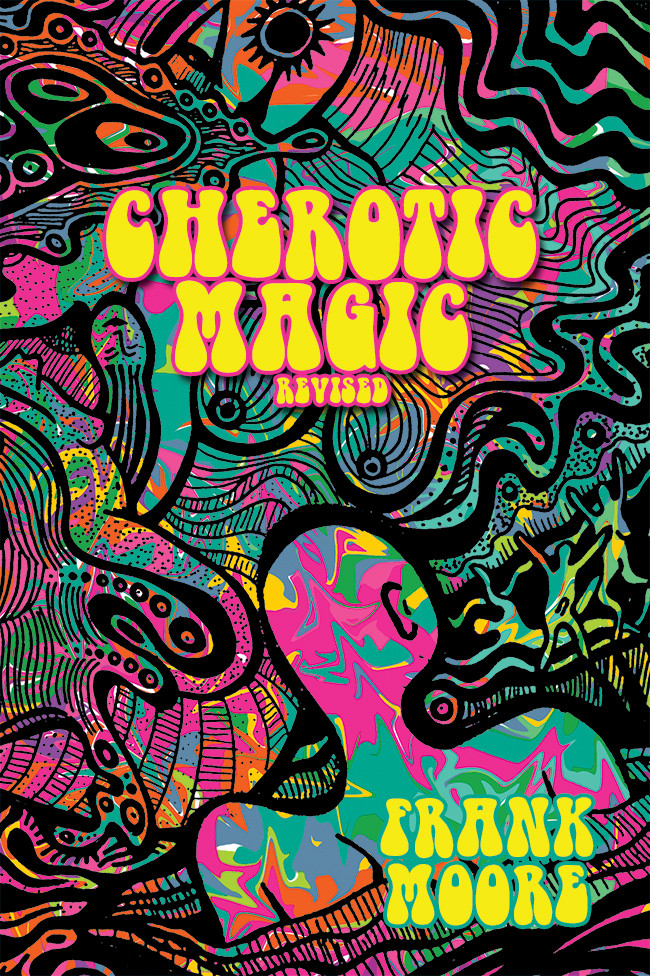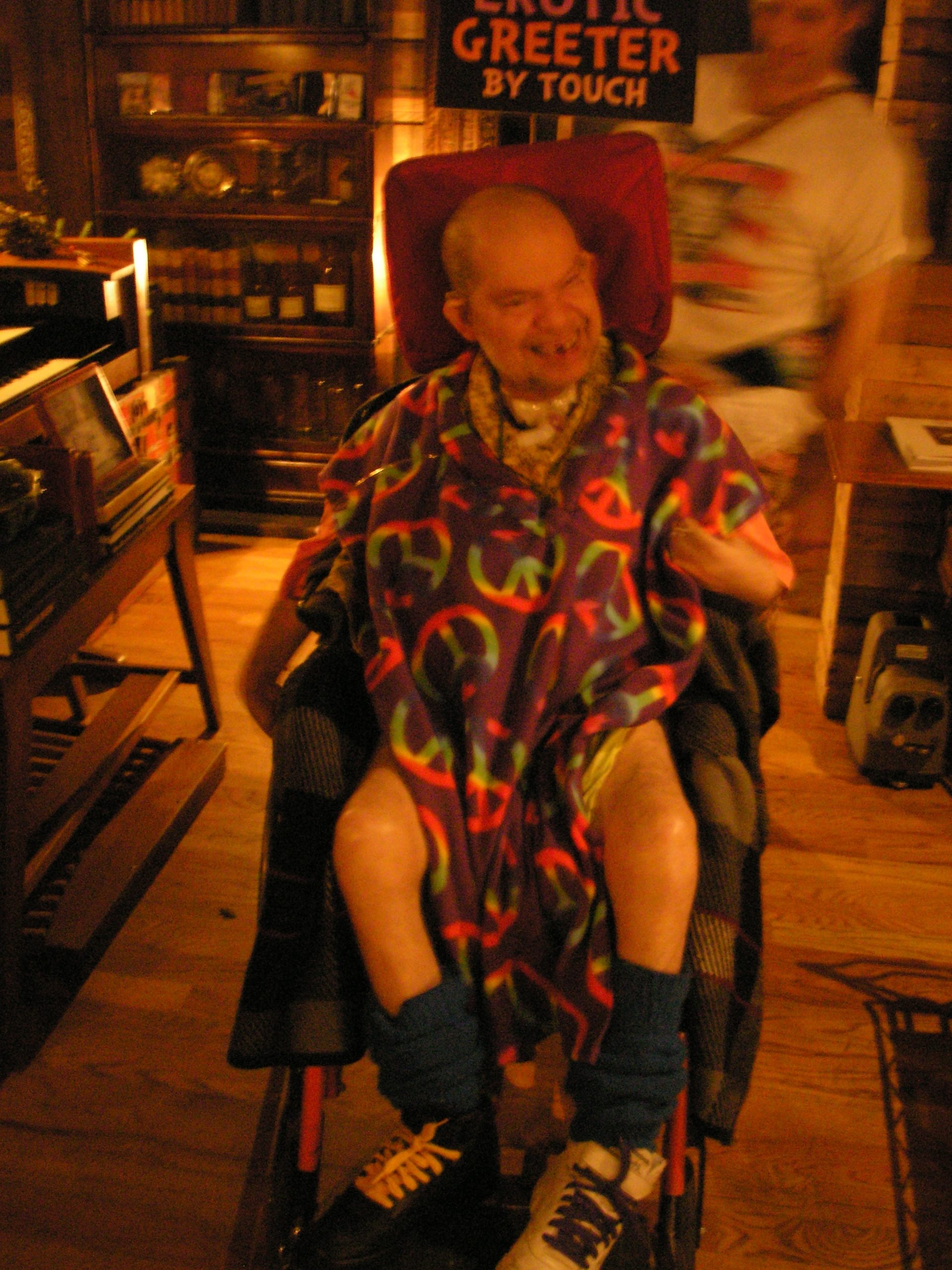
Cherotic Magic by Frank Moore
by Barbara Smith, 1991
Due to complex reasons of historical conditions and need, artists from the industrialized nations of the world more or less simultaneously (late 1950’s – early 1970’s) felt a depth of experience uncontainable in ordinary and available cultural forms. They emerged with a language of remarkable similarity – clearly felt in retrospect to be shamanic and whose purposes extended far beyond the realm of the commercialized art market. One of these performance artists is Frank Moore who has just published an introductory manual for prospective apprentices in shamanic/art practices. The book is also a very helpful means of access to this particular realm of performance art for the historian and student.
Moore, paradoxically a severely disabled cerebral palsied human being, who cannot clearly utter a single word is simultaneously a clear and eloquent writer about a reality-shifting form of art he calls Cherotic Magic and a spectacularly courageous, ecstatic journeyer and practitioner of shamanic transformational art.
Reversing the ideas of normal causality, his book guides one towards powerful experiences of re-integration into a unified field of consciousness brought about by the apprenticeship. The radical purposes of the book initiate a teacher/student relationship more appropriately similar to a guru situation than the normal art student context which we all know can be one which borders on charismatic adulation. Rather, the relationship is intended to awaken and restructure the whole being with access to an interrelated “web of all possibilities,” a potentiated ground of existence, from which the student may return empowered with energy, vision and unflinching faith to change the so-called reality structure of this fragmented and specialized culture. The process is a form of magic, which inspires a sense of body wholeness and aliveness where the personal power is to be found. A manual of faith and a description of the nature of apprenticeship, the book is a clarification of the sort of contractual agreement one enters with a teacher, rarely stipulated but here clearly spelled out. This agreement is one of mutual responsibility where the risk is clearly seen to be taken by both parties.
Having explored these realms a good deal myself both in terms of self-discovery and also with teachers, I find the book to be rigorously tough in its demands (on the potential student and quite naturally the teacher as well), and it also very clearly describes qualities required (such as trust) and the benefits to be gained in these explorations (such as love).
Moore has broken the apprenticeship into segments with re-entry periods back into ordinary life between the intervals in order to accommodate Western students’ difficulty in going through the lengthy course in a sustained fashion. The fact that the student must exhibit a deep and long-term calling, will or faith to repeatedly return to the teaching is Moore’s greatest risk, for spiritual apprenticeship is not a common practice in Western culture. This is a little known fact that the apprenticeship entails risk in the making and/or breaking of the relationship not only in regard to the student but more so for the teacher.
Moore speaks of the a-logical interaction, as a journey along which student and teacher become soul mirrors. Moore is not seeking a following, however. He states to his credit, I believe, that such work is highly personal and requires one-to-one attention and becomes non-productive when he has many followers.
The radical nature of this esoteric apprenticeship practice includes the breaking of social mores and taboos in order to reach direct experience particularly in the realm of conventional sexuality. Moore clearly states however that the touching and erotic playing involved (Eroplay) is not driven by the goal of sexual intercourse, but is the refreshing awakening of what he calls Cherotic energy which becomes a free fund of available and heightened “juice” for healing and creativity. (These teachings parallel quite exactly the teachings I’ve experienced from my Native American shaman teacher and also Tantric practices.)
My first response to reading Cherotic Magic is one of resonance and appreciation, the feeling of knowing very deeply that of which he speaks as true and uncompromising. He gives examples and authentication through powerfully written, illuminating stories about his own early life of terrible isolation and study; the breakthroughs which allowed him to finally believe in his own intelligence, joy and beauty and to receive the powerful inner flow of intrinsically experienced wisdom and knowledge of these liberating teachings. These life passages correspond to such experiences of mystics everywhere. I appreciate many things about this book, not the least of which are the words Moore has coined to name certain qualities and goals of his work (such as Eroplay and Chero). One such word Erour, means vulnerable strength. Its meaning corresponds exactly to my own early performance experience. In the past, I put myself in very psychologically risky positions in performances and I was frequently criticized for doing so as if I were “hurting myself”. My own experience was quite to the contrary, although I was in fact going to “the place of fear or pain or constraint” in myself with vulnerability and because I deliberately chose to do so, it was an act of strength and I returned with released energy and power.
If anything in his book is weak, it is this issue of authority and how to define the limits (and/or goals) of guru/student practice. It is weak not because I think Frank is either weak or inauthentic … but because we live in a spiritually naïve culture. Most people I imagine are cynics. The book is not written for such people as there is no language that I know of to convince them a priori to any experience which in itself is convincing. Further, the way one meets one’s teachers in life is often inherently mysterious and a unique process. Perhaps the only ways a potential student can judge such persons and situations have first of all to do with one’s depth of calling and an experienced synchronicity. Failing that, one needs to feel one may leave the teacher at any time despite the pressure to stay and one can also inquire of former students as to their experience.
For me, it would be advantageous if he could paint a picture of what completion might look like. Is it simply staying the course (twelve years for a resident; seven on, five off approximately / seven days for the introductory course)? The difficulty is that completion of such a practice might look very different in each of the “graduates” and only a sense of demonstrable knowing and changed behavior would be adequate.
The book is replete with black and white drawings by Michael LaBash. Depending on prior biases, they can appear to be psychedelically violent and visceral with a heavy emphasis on sex. They are intricate intertwinings of interpenetrating fields which writhe over the entire drawing area with no central image. Rather, naked figures whole or in parts of both sexes and composite hermaphrodites with breasts and cocks weave in an out of planes and orifices. As I have said, Moore speaks in the text of making clear how Eroplay is not to be thought of as driving for sex or focused on it. Rather it comes from a presexual state of infancy, yet here the drawings are strongly sexual in my view and often horrific. (No doubt, however, not meant so much to be sexual as frank (pun intended).
Moore’s writing about the ethics of commitment is a powerful critique of our shallow culture. What he says rings true and created a sense of gratitude in me and inner resolution. He speaks with great personal authority.
In the general dialog of art and culture this form of art appears to be the most difficult to speak about partly due to its radicality and partly because it re-integrates art into religion, magic, belief, and effect. It means and makes change. I, myself have twice come to a bifurcation point re: some need to synthesize art as I practice it somewhat within the cultural dialog and spaces of my profession as against a chosen spiritual path (Buddhism or Native American teachings). I finally had to ask the question: which was my core path, art or the spiritual path? And could the creative process itself be a path to spiritual awakening and inner knowledge? Or was a core of spirit teachings the only way and the art must be derived from it. Not the least of which is the question of feminism. The female spiritual journey is for me a major issue within this questioning.
Moore himself raises the question of Shamanism /as art – /as performance – /as therapy. He cites performance as the bed of mystical initiation, rites of passage, mystical ceremonies where art/science, philosophy, and psychology and theology merge and become whole once again. Here, we may experience these things as at once ancient and strange. The breaking of restricting taboos and inner barriers moves towards a place not of isolated individualism, but one of connectedness both in the interior landscapes and with each other.



More information about the book, Cherotic Magic Revised, is available here: http://www.eroplay.com/cheroticmagic/




